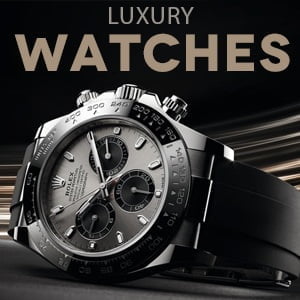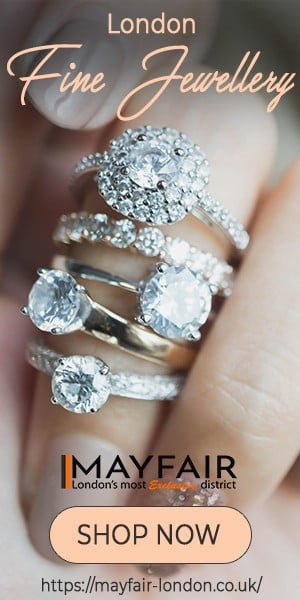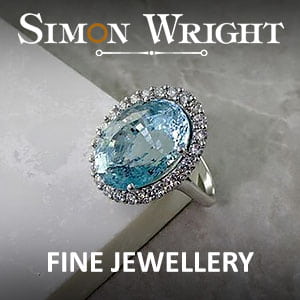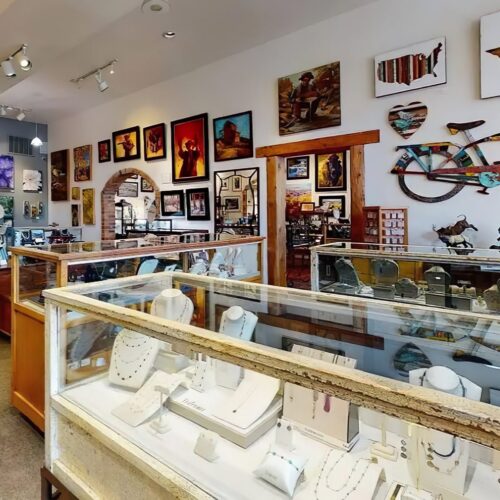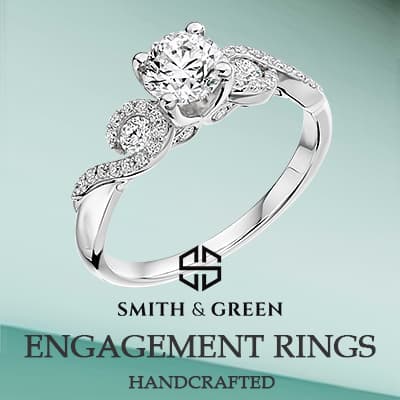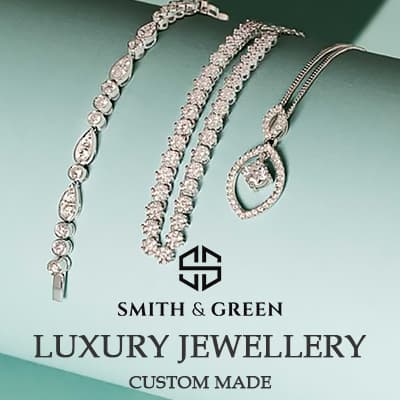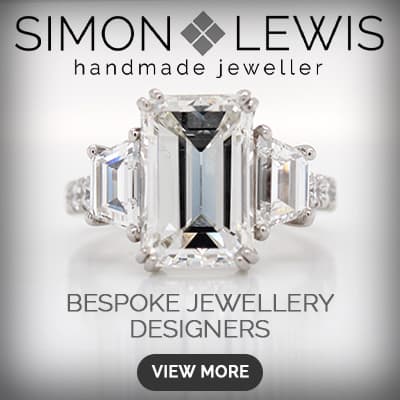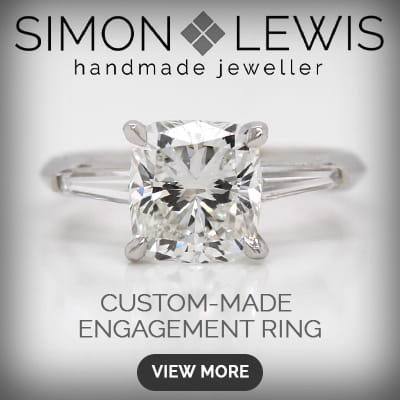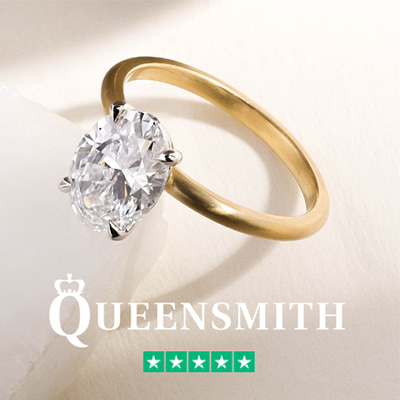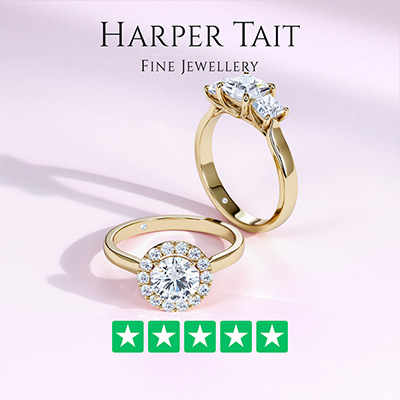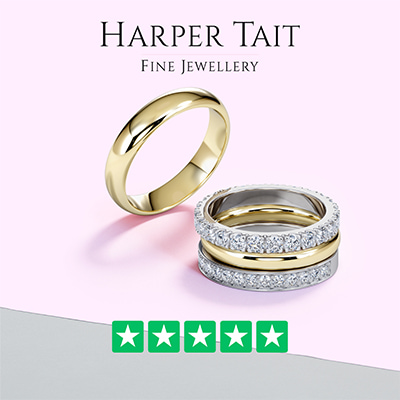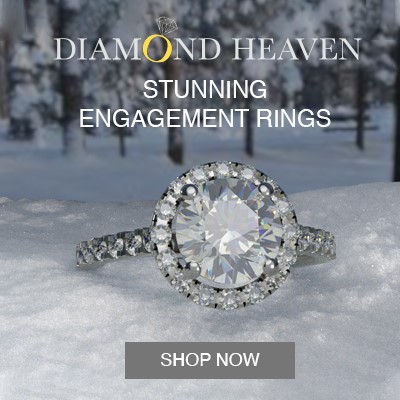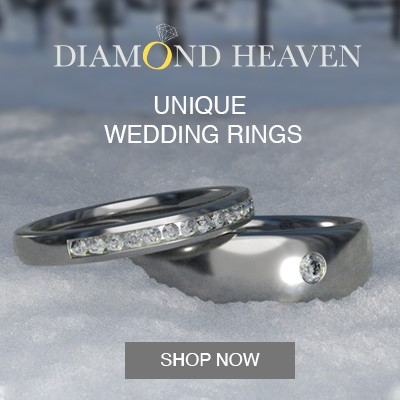Engagement Ring Styles
Get to know the ins and outs of engagement ring design, to help you make the most informed decision. This rich and detailed guide to engagement ring styles takes you through the most sought after contemporary diamond rings.
Halo Engagement Rings
Halos are a popular design element that dates back to the Victorian period when small pearls or diamonds were used to enhance centre stones. Often using coloured gems for the centre stone, Victorian halo rings were designed to imitate flowers. The style gained prevalence in the 1920s Art Deco period when geometry and symmetry ruled design. Halo engagement rings today have had a resurgence in popularity, thanks to the ability to maximise size without maximising your budget.
A halo setting is the addition of small diamonds set around the centre stone. A halo can simply be a circle of melee diamonds around the round brilliant centre stone or could involve intricate shapes, patterns and metal detailing. A halo maximises the size and sparkle of the ring and should complement the centre stone. It is important that the smaller diamonds are perfectly calibrated with the centre stone in terms of cut, clarity and colour, to demonstrate consistency. When the halo diamonds are brighter and clearer than the centre stone, the centre stone may appear more yellow or grey in contrast. At Queensmith, we ensure any additional diamonds added to a centre stone are perfectly calibrated, for the most beautiful outcome.
If the size of the ring is the main priority, a halo can be a great choice. The size of the ring is maximised by the addition of the smaller diamonds, meaning the centre stone can be on the smaller side and can work to a stricter budget. A ring can have more than one halo, which is great for those looking for intricacy or a two-tone halo.
For a simple halo, see the Classic Oberon. The Classic Kelly is similar in style, and makes use of the optimal fire, scintillation and sparkle of a round brilliant, whilst honing the look of a cushion-cut due to the slightly squared halo. For a nod to vintage design, check out the Rainer, which adds intricate detail to the centre stone, and the Velez Pavé for something innovative and totally unique.
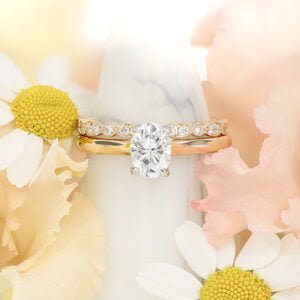
Solitaire Rings
Solitaire engagement rings are masters of simplicity. The term means that one centre diamond is used without any other stones around it: all eyes are on the one and only diamond, without distraction. This is widely recognised and the most popular style of engagement ring, and since its creation in the 1800s has never gone out of style.
The use of one diamond and a simple band allows for maximum light play and therefore great sparkle. Choosing a centre diamond is important for any ring style, but the centre stone is very much in the spotlight with a solitaire, so you should consider the right balance of cut, clarity, size and colour. Our expert gemologists are always able to answer any questions you might have about this.
It’s important any fantastic diamond has an equally fantastic setting to show it in the best light. The diversity of solitaire settings allows for both traditional and contemporary rings. With a number of settings perfectly engineered to allow light to pass through the diamond, we’re able to cater for every taste, from the twisted setting of the Turner to the illusion of the diamond floating in the setting of the Harlow. The rub-over setting of the Darrieux is an ultra-modern way to frame a diamond and a popular choice among millennials and minimalists alike.
The use of a fancy shape can make a solitaire engagement ring all the more striking, from the angular Princess Cuts of the De Carlo and Hayes designs, to the timeless look of the Emerald Cut Tierney and Oval Tierney. Browse more fancy shape designs here.
Fancy Shape Rings
When a diamond is cut from its original rough form, around 50% of its weight is typically lost. Rough diamonds are sorted to determine which diamond shape with making the most us of the size and shape of the rough diamond. When a round brilliant cut diamond is not possible, the destiny of the stone will be to become a fancy shape. The square, princess cut is the most popular fancy shape; the many-faceted stone is a perfect stone for maximum brilliance and thus sparkle, meaning any inclusions become less visible to the naked eye. See the De Carlo for square simplicity, or the Pavé version for added sparkle.
An emerald cut is inherently timeless. The rectangular shape consists of a few facets and a large table, therefore the cut does not permit for a lot of sparkles. The style, however, is often used for art-deco inspired pieces due to its long, sharp glamorous lines. This one is popular among Hollywood stars alike, from Beyonce and Amal Clooney to Elizabeth Taylor and Grace Kelly. The Emerald Tierney is ideal for an emerald cut show stopper, whilst the Novak gives a nod to vintage style.
The pear cut is a popular choice for a striking engagement ring, for those after something unique and contemporary. An oval cut is effortlessly elegant – a great solitaire choice for those with small hands or short fingers, to help elongate the hand, as with the Oval Tierney Pavé. See the Bacall for something more traditional. Marquise diamonds are dramatic and eye-catching. Similar to an oval, the marquise is long and slender, but this the addition of tapered ends, and due to the length of the stone can have the illusion of looking bigger than it is. Cushion cut diamonds are always a romantic choice. The stone is cut similarly to a square or rectangle, but with round edges.
Diamond Band Rings
Adding diamonds to a band can add detailing, intricacy and, of course, sparkle. The diamonds used on the band are melee diamonds, meaning they weigh less than 0.18 carats and as little as 0.001 carats. There are a few ways to set the diamonds, the most popular being pavé, scallop and fishtail styles, which show the diamonds in their best light. Channel and flush settings can also be used within the band, offering more of subtle sparkle. A beautiful way to add to the intricacy of a pavé diamond band is to add a milgrain effect. Some of the most popular designs on the Queensmith site include the Turner Pavé, Fontaine Scallop, Temple Pavé, and Harlow Scallop to name a few.
Trilogy Rings
Why have one diamond when you can have three? Aside from their ability to maximise the size and sparkle of an engagement ring, trilogy rings have a special significance. Some regard the series of rings as symbols of your past memories together, present happiness and future relationship. Many couples love the way a trinity ring embodies their story together. The ‘present’ stone is the biggest stone, placed in the centre of the ring – after all, there is no time like the present. Others interpret the trilogy of diamonds to represent friendship, love and fidelity. Of course, many like to have their own meanings that truly represent them and their relationship. Whichever way you interpret it, a trilogy ring will always have a precious meaning behind it, suiting those wanting to encapsulate a greater meaning in their ring.
Trilogy rings typically come in a number of styles, the most popular being graduated. This usually means the weight of the centre two is equivalent to the two outer stones put together, similar to that of Prince Harry’s engagement ring for Meghan Markle. For example, a 0.50-carat centre diamond would be framed with two 0.25 carat stones. For a less dramatic difference between the centre and outer stones, choose a ‘slightly graduated style’. A graduated or slightly graduated engagement ring is the perfect way to emphasise the importance of the centre, or ‘present’ stone, such as in the Leigh. Using equally sized diamonds is more unusual, and makes for a unique engagement ring. For something alternative, try step cut baguettes to support the centre stone, such as in the Winters engagement ring, or like the Lamar use two delicate pear diamonds to draw the eye towards the round brilliant centre diamond.
A trilogy ring is also a great way to get around a tighter budget. Making up a carat weight with three stones will be significantly less costly than buying one diamond of the same carat weight. The bigger the diamond, the rarer and thus more expensive it is. A smaller stone can be used in a trilogy than what might be chosen for a solitaire because of the two supporting stones with enhancing the size of the ring. Adding a halo as well as this will ensure a show-stopping engagement ring, such as the Sheridan.
Bespoke Engagement Rings
If you’re looking for bespoke engagement rings in London, look no further! At Queensmith, every ring is made to order. If you have a design in mind, we can do it! We have an in-house design team and workshop at our Hatton Garden jewellers. Let one of our bespoke engagement ring specialists take you through the full catalogue of options that are available to you. If you have inspiration from elsewhere, then bring it along to your consultation… The likelihood is that we’ve already made something similar!
Head over to the Queensmith site for more information on Engagement Ring styles and how to create your own perfect proposal.
www.queensmith.co.uk


